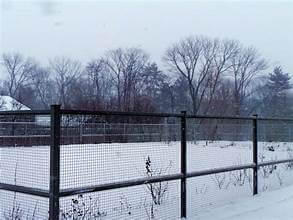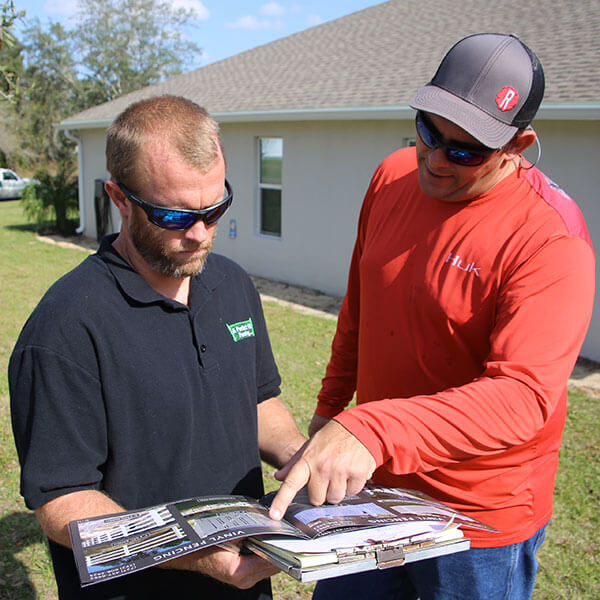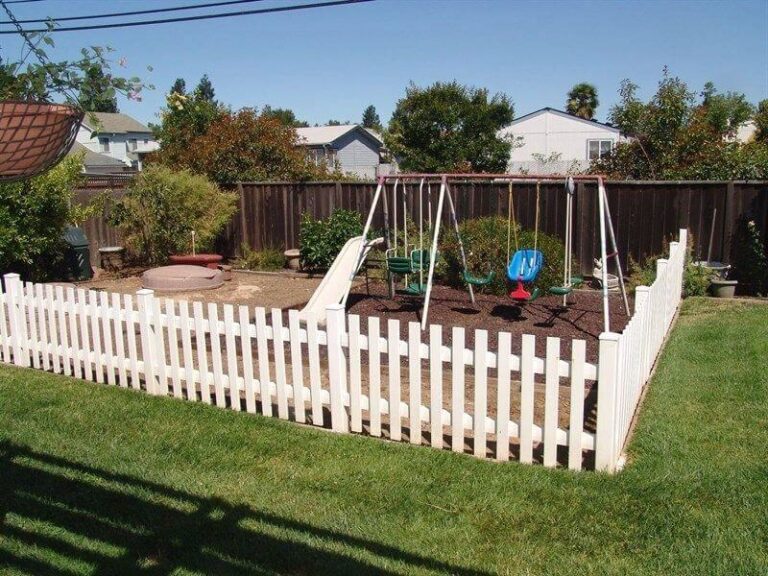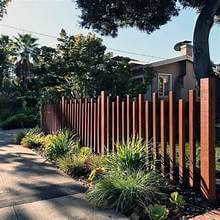When choosing fencing for blizzards and snowstorms, prioritize durable materials like steel and vinyl. Consider the fence’s height and spacing to prevent snow buildup and ensure proper installation to withstand harsh weather conditions.
In snowy climates, it’s vital to select fences that can withstand the weight of snow and remain intact during blizzards and snowstorms.
Factors such as material durability, spacing, and installation all play crucial roles in ensuring your fence can withstand the elements effectively.
Living in an area prone to blizzards and snowstorms requires careful consideration when selecting fencing.
The right fencing can provide security, privacy, and aesthetic appeal while also withstanding the challenges posed by severe winter weather.
In this guide, we’ll explore the essential tips for choosing fencing that can endure the harsh conditions of blizzards and snowstorms, allowing you to make an informed decision that will protect your property for years to come.

Understanding The Impact Of Blizzards And Snowstorms On Fencing
Blizzards and snowstorms can pose significant challenges to the durability and integrity of fencing.
Understanding the impact of these weather phenomena is crucial for selecting the right fencing option that can withstand the harsh conditions.
Here are some key factors to consider when choosing fencing in blizzards and snowstorms.
Snow Load On Fences
Snow load, the weight of accumulated snow on a fence during a snowstorm, can compromise its integrity.
To ensure durability, select materials and designs capable of withstanding regional snow loads.
In snow-prone areas like San Mateo, consider reinforced options. Preventative measures, such as regular snow removal, are crucial. For robust fencing solutions, Contact Us for a Quote.
Damage Caused By Strong Winds
Strong winds accompanying blizzards and snowstorms can cause direct damage to fencing structures.
High winds can push snow against the fence, adding to the snow load, and also lead to bending or breakage of the fence components.
Selecting fencing materials designed to withstand strong winds, such as sturdy posts and secure fastenings, is vital for minimizing wind-related damage.
Importance Of Material Strength And Durability
The strength and durability of fencing materials are paramount when facing blizzards and snowstorms.
Opt for materials such as steel, aluminum, or vinyl that are known for their resilience in harsh weather conditions.
Ensure that the chosen fencing material is treated or coated to resist corrosion and damage from moisture, snow, and ice.
Additionally, regular maintenance and inspections can help identify and address any potential weak points before they lead to significant damage.
This HTML content provides valuable tips for choosing fencing in blizzards and snowstorms, highlighting the impact of snow load, strong winds, and the importance of material strength and durability.
The use of headers, bold text, and concise paragraphs is aimed at enhancing readability and SEO-friendliness.
Selecting The Right Material For Snow-resistant Fences
Evaluating The Durability Of Different Materials
When it comes to selecting the right material for a snow-resistant fence, durability is paramount.
Evaluating the durability of different materials is essential in ensuring that the fence can withstand the harsh conditions of blizzards and snowstorms.
For areas prone to heavy snowfall, opting for a material with high durability is crucial to avoid frequent repair and replacement.
Benefits Of Metal And Vinyl Fencing
Metal and vinyl fencing are two popular choices when it comes to snow-resistant fences.
The benefits of these materials are significant, making them ideal for snowy climates.
Metal fences, such as steel or aluminum, offer exceptional durability and strength, making them highly capable of withstanding heavy snow loads without buckling or breaking.
On the other hand, vinyl fences are not only durable but also resistant to moisture and corrosion, making them well-suited for snow-prone regions.
Resistance To Corrosion And Weathering
One crucial aspect to consider when selecting a snow-resistant fence material is its resistance to corrosion and weathering.
Snow and ice can introduce moisture to the fence, leading to the potential for rust and deterioration.
Therefore, opting for materials that exhibit exceptional resistance to corrosion and weathering is paramount.
Metal and vinyl fences are known for their ability to resist corrosion, ensuring longevity and minimal maintenance even in the harshest snowstorms.
Hiring Professional Installation Services For Snow-resistant Fences
When it comes to choosing fencing that can withstand blizzards and snowstorms, hiring professional installation services is crucial.
Professional installers have the expertise and resources to ensure that your snow-resistant fence is properly anchored and structurally stable, effectively protecting your property during extreme weather conditions.
Importance Of Professional Installation In Snowy Climates
Professional installation is essential in snowy climates to ensure that the fence is installed correctly to withstand heavy snow loads and high winds.
Improper installation can lead to fence damage, compromising its effectiveness in protecting your property during blizzards and snowstorms.
Professional installers have the necessary knowledge and experience to select the right materials and installation methods for snow-resistant fencing, providing you with peace of mind during severe weather.
Expertise In Handling Extreme Weather Conditions
Professional installers specializing in snow-resistant fencing have extensive experience in dealing with extreme weather conditions.
They understand the unique challenges posed by blizzards and snowstorms, allowing them to tailor the installation process to ensure maximum resilience against harsh weather.
Their expertise enables them to anticipate potential issues and implement proactive measures to mitigate the impact of snow and ice on the fence, enhancing its durability and longevity.
Ensuring Proper Anchoring And Structural Stability
One of the key advantages of hiring professional installation services for snow-resistant fences is the assurance of proper anchoring and structural stability.
Professional installers have the tools and techniques to secure the fence firmly into the ground, preventing it from becoming dislodged or collapsing under the weight of snow accumulation.
By prioritizing structural integrity, they ensure that your snow-resistant fence remains fully functional and protective, even in the most challenging winter conditions.
Snow Removal Techniques For Fences
When it comes to maintaining fences during blizzards and snowstorms, it’s essential to implement effective snow removal techniques.
Safely clearing snow and ice from fences, minimizing potential damage during snow removal, and using recommended tools and equipment for maintenance are crucial aspects to consider.
Safely Clearing Snow And Ice From Fences
- Use a plastic shovel or snow blower to gently remove snow from the fence, avoiding excessive force that could cause damage.
- Clear accumulated ice cautiously to prevent scratches or dents on the fencing material.
- Apply a de-icing solution to facilitate the removal of stubborn ice without damaging the fence.
Minimizing Potential Damage During Snow Removal
- Avoid using metal tools that can scratch or dent the fence material. Opt for plastic or rubber equipment.
- Be mindful of the fence structure and components while removing snow to prevent bending or warping.
- Shovel snow in a downward motion to prevent upward forces that could dislodge or damage the fence panels.
Recommended Tools And Equipment For Maintenance
When maintaining fences during snowstorms, it’s essential to have the right tools and equipment. Below are some recommended items:
| Tools | Equipment |
|---|---|
| Plastic shovel | Snow blower |
| Snow rake | De-icing solution |
| Rubber mallet | Protective gloves |
Protective Coatings And Treatments For Snow-resistant Fences
Implementing Protective Coatings For Enhanced Resilience
When choosing fencing for blizzards and snowstorms, it is essential to implement protective coatings that enhance the resilience of the structure.
Protective coatings such as galvanization or powder coating can provide a layer of defense against the corrosive effects of snow and ice.
Weatherproofing Techniques For Long-lasting Durability
In addition to protective coatings, weatherproofing techniques are crucial for ensuring the long-lasting durability of snow-resistant fencing.
This can include sealing the fence with weather-resistant finishes, applying rust-inhibiting treatments, and using materials that can withstand extreme temperature changes without compromising their structural integrity.
Routine Inspections And Upkeep For Snow-resistant Fencing
To maintain snow-resistant fencing, routine inspections and upkeep are imperative.
Regularly inspecting the fence for any signs of damage, such as rust or corrosion, and promptly addressing any issues can help prevent snow-related damage and ensure the fence remains resilient in the face of blizzards and snowstorms.
Implementing a maintenance schedule that includes cleaning, repainting, and reapplying protective coatings as needed can contribute to the overall snow resistance of the fencing.

Frequently Asked Questions
What Are The Best Fencing Materials For Blizzards And Snowstorms?
To withstand harsh weather, consider steel or aluminum fencing for durability and minimal maintenance.
How High Should A Snowstorm Fence Be For Effective Protection?
Aim for a fence height of at least 4 feet to effectively minimize snowdrifts and ensure long-term stability.
Can Certain Fence Designs Prevent Snow Accumulation In Blizzards?
Yes, board-on-board or lattice fencing can limit snow build-up and provide better visibility in snowy conditions.
Conclusion
In preparation for blizzards and snowstorms, choosing the right fencing is crucial for maintaining property safety and security.
With the right materials and proper installation, you can effectively withstand the harsh winter conditions.
Keep these tips in mind to make an informed decision and ensure your fencing can weather any storm.







